Article
Visiting Europe's Great Contributors to Medical History
Author(s):
Medical historians agree that most of the major contributions to medicine made in the last 500 years came from Europe -- many not made by physicians, but by scientists and lay persons. We visit of some of the great contributors.
Photography by author.
Medical historians agree that most of the major contributions to medicine made in the last 500 years came from Europe -- they have been at it longer than we have in North America. Interestingly enough, many of the great medical discoveries were not made by physicians, but by curious scientists and lay persons. This week we'll take a tour of some of the great contributors.

So we find this in Leiden, the Netherlands where, arguably, the first microscopes were designed -- not by a scientist, but by a wealthy merchant, Antoni van Leeuwenhoek. Though he wasn’t a doctor, Leeuwenhoek dedicated himself to microscopy for most of his 90 years. He significantly developed the work of an earlier Italian anatomist, Marcello Malpighi. Leeuwenhoek was finally made a Fellow of the prestigious Royal Society in London, a rare honor. His microscope and portrait can be found at the Boerhaave Museum in the Netherlands.
Surprisingly though the Netherlands Tourist Office is considered one of the best in Europe, it offers little help to the visitor to this charming medieval city. I had problems getting into the Institut Pasteur in France, though I had an appointment (“as long as I didn’t touch anything”) to photograph Louis Pasteur’s lab equipment.
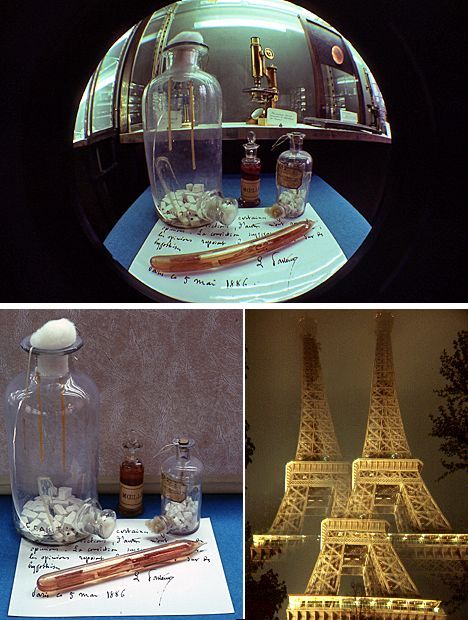
I picked up a container holding a specimen of spinal cord Pasteur had used to make his rabies vaccine. The first thing I noted on it was a scribbled message that Pasteur had written on the jar with a red grease pencil. It said “Caution! There is a crack in this vial.” (After I put my cameras away I scrubbed and scrubbed my hands.)
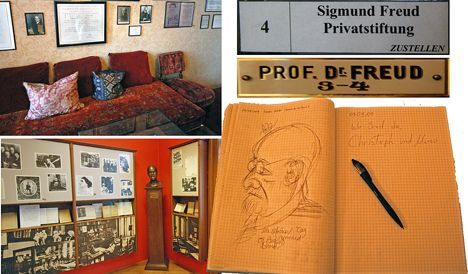
I wondered if Sigmund Freud would have thought that intense washing a bit obsessive as I later struggled up the worn steps to his consulting rooms at the Sigmund Freud Museum at Bergasse 19 in Vienna. If I had been there when he was still practicing, would he suspect I was blaming my life’s problems on my mother? Or maybe his?
How would I diagnose him? I have clues: his furnishings, his hats hanging there on hooks before me, his note books, his doctor’s bag and photographs of him wearing his beard. Aha! I recall what a psychologist once told me when we had dinner together. I had just come back from a wilderness experience in the Queen Charlotte Islands, now a Haida National Park. The yacht’s skipper had asked us not to shave and cast hair debris into the pristine waters. I had grown a beard. I leaned over the table and wondered to my companion, “Do psychologists have an opinion as to why men grow a beard?” He considered this and replied: “Yes. Laziness, conceit, eccentricity, arrogance, affectation!”
I have thus diagnosed this bearded Freud, who would have dared to think I blame life on my mother or his. He was an affected lazy eccentric. Diagnosis made.
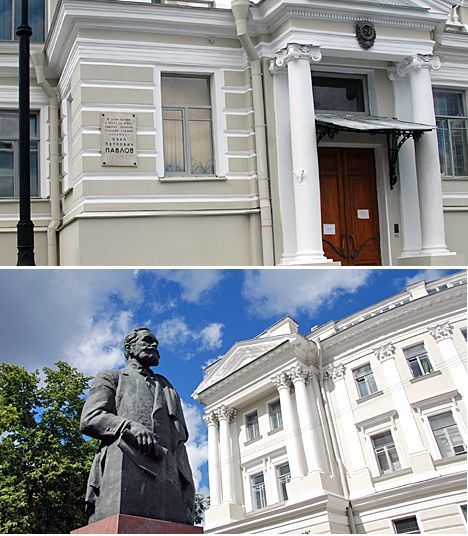
When I looked up at the statue of Ivan Petrovich Pavlov in St. Petersburg, I mused that maybe Pavlov made more sense to a dour Scottish family physician like me than a fastidious Viennese psychoanalyst does. Pavlov’s physiological explanations of, say, gastric digestion sound more scientific than Freud’s emphasis on the sexual fantasies of Viennese ladies.
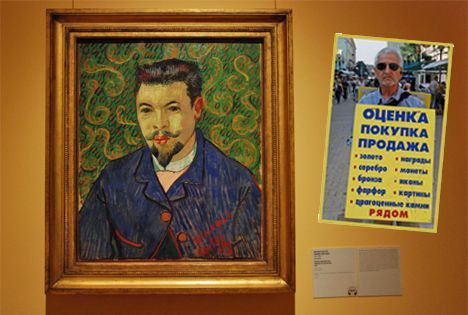
But I had something else to do.
As long as I was in Russia, I took the chance to go to the Pushkin Museum in Moscow to see, at last, Vincent van Gogh’s portrait of his physician, Dr. Felix Rey. About this much had been written. His Arles physician didn’t really like it or want it, and for years used it to block a hole in the wall of his chicken coop until someone told him it now had value. Seeing it must have made my head spin, because I stopped a street vendor outside and traded a bar of chocolate for the use of his advertisement board while he took my photo. I shudder to think what the Russian words might have said.
Then there’s London and Alexander Fleming. I’ve always had a soft spot in my heart for him (and Winston Churchill, whom I’ve added to the picture). True, Fleming discovered the medical uses of penicillin, but thought his findings of little practical value -- that was a full 11 years before Oxford scientists and American ingenuity developed its value as Britain went to war. But to have a weapon against bacteria was magical for us and God knows how many moribund patients it cured in the 20th Century.
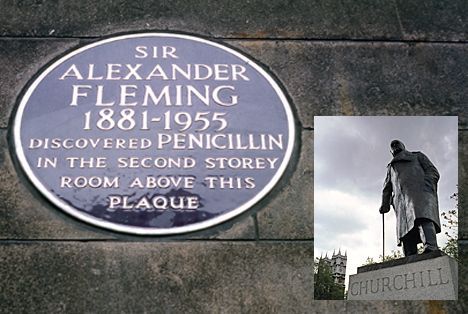
Fleming died in 1955 when I was halfway through the six-year medical curriculum in Britain and I still remember the event. Fleming’s wife was Greek and when he died Greece flew its flag at half-mast. Penicillin cured so many children of rheumatic fever at that time when streptococcus was king that once, when Fleming went to attend a medical conference in Paris, mothers kneeled to kiss his hand -- something that would have appalled this modest, sensitive man.
I love the story that when a BBC broadcast news reporter went to St. Mary’s Hospital in London to break the news in 1944 that Fleming had just been knighted, they couldn’t find him in his part of the hospital. After asking a nurse, she replied: “Oh, he’s in the kitchen at the end of the hallway. It’s his week to make the tea.”
Eric Anderson, a retired physician who lives in San Diego, is one of the resident travel & cruise columnists for Physician's Money Digest. The one-time president of the New Hampshire Academy of Family Practice, Eric is the only physician in the American Society of Travel Writers. He has also written five books, the last called The Man Who Cried Orange: Stories from a Doctor's Life.




